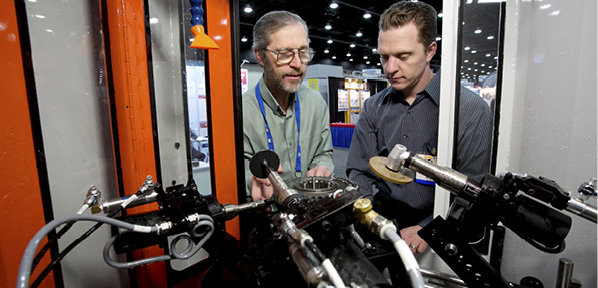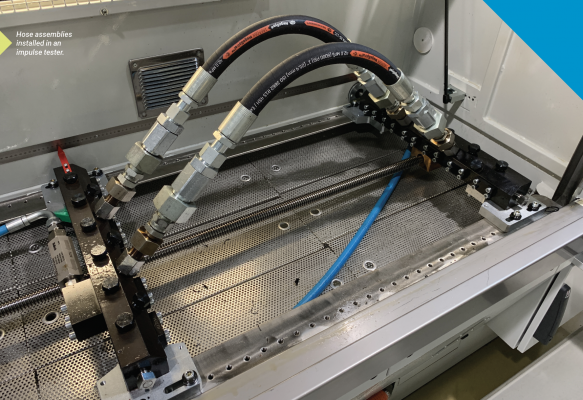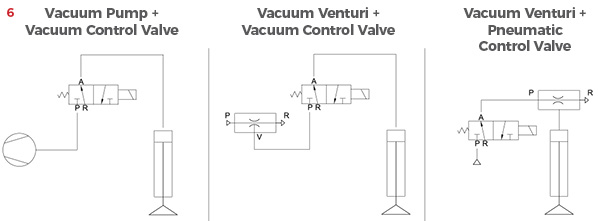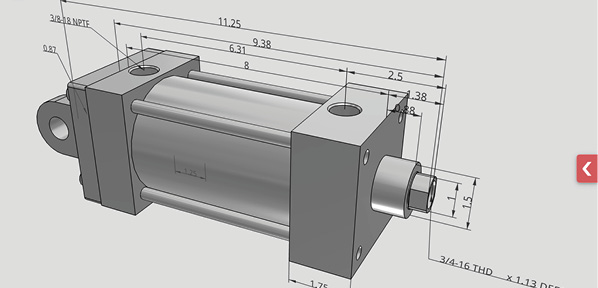Tailoring Comprehensive Filtration Programs to Meet Your Needs
By Peter Skoog, Technical Manager, Fluid Power and Grease, Quaker Chemical Corporation

The primary functions of a hydraulic fluid are to:
- Transmit force
- Lubricate moving parts
- Dissipate heat (cool moving parts and other components)
- Seal clearances between parts
Solid contamination interferes with the first three functions. First, it interferes with power transmission by blocking or plugging small orifices in pressure relief valves and flow control valves. Second, solid contamination can alter the cooling process by plugging heat exchangers and by building up in the reservoir. Both of these conditions reduce the heat transfer needed to give maximum system performance and fluid lifetime. Most importantly, solid contaminants have a negative effect on the lubricating properties of the hydraulic fluid.
Solid contamination comes from different-sized particles. Very fine particles (silt) that are smaller than the components mechanical clearances can collect in fine tolerances and block the flow of hydraulic fluid into the small spaces between moving parts. This physically limits the amount of lubrication going to a specific component. Silting can also limit the movement of components like valve spools.
Larger contaminants – particles that are roughly the size of the mechanical clearances in a piece of machinery – cause the most damage in a hydraulic system. These particles cause abrasive wear and tear across the moving surfaces in a component. This damage increases internal leakage, lowers system efficiency, and generates heat. The higher the system pressure, the more problematic abrasive wear becomes.
Large, solid particles cannot work their way into fine clearances to cause abrasive wear, but do present problems. These particles can block lubricant flow between moving parts. They also tend to jam pumps valves and motors. These conditions all highlight the need for good filtration (contamination control) in a hydraulic system.
When selecting a filter or replacement element, it is important to address the following questions:
- What type of oil are you filtering?
- Where will the filter be located?
- What is the required cleanliness level of that specific system?
- Are there existing problems that need to be addressed?
Mineral oil is far and away the most widely used hydraulic medium. One can easily find information on the filtration, care and maintenance of this type of fluid. The following discussion will be limited to specialty fluid like fire-resistant hydraulic fluids and bio-based or biodegradable fluids.
Anhydrous (water-free) Fluids
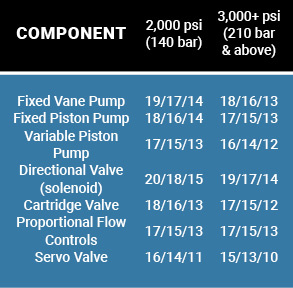 Anhydrous fluids (HFD-U), whether they are synthetic or based on a naturally occurring base stock, can be treated very much like mineral oil when selecting filter media. Synthetic, as well as cellulosic media, can be used with these fluids. However, because the fluids are synthetic and will vary in chemical composition, it will be necessary to check the compatibility of the filter medium, seals, and adhesives used in the filter element with the fluid that has been selected. Both the filter manufacturer and fluid supplier should be able to provide guidance in the fluid selection process.
Anhydrous fluids (HFD-U), whether they are synthetic or based on a naturally occurring base stock, can be treated very much like mineral oil when selecting filter media. Synthetic, as well as cellulosic media, can be used with these fluids. However, because the fluids are synthetic and will vary in chemical composition, it will be necessary to check the compatibility of the filter medium, seals, and adhesives used in the filter element with the fluid that has been selected. Both the filter manufacturer and fluid supplier should be able to provide guidance in the fluid selection process.
Water-free fluids are normally used in high pressure or high-heat environments. These severe operating conditions will require fine filtration. The chart on the left offers some guidance:
Attaining high fluid cleanliness requires a plan. Simply putting fine filters with high beta ratings (β • 1,000) in a system may not produce the desired results as filter consumption might be excessive. Sometimes staged filtration – using finer and finer filter elements – may be required. Filtering fluid from its shipping container into the reservoir will aid in meeting a cleanliness objective. A side benefit of instituting a filtration program is increased fluid life. Wear debris particles have a high surface area and can act as catalysts in fluid degradation. Removing wear debris slows the chemical breakdown of synthetic and natural hydraulic base stocks.
Water-Based Fluids
Water glycol hydraulic fluids (HFC) are the most widely used and well-known water-based hydraulic fluids. These fluids are true solutions composed of soft or deionized water, a polyglycol thickener, glycol, and an amine-based additive package. Being a true solution, it is virtually impossible to remove major fluid components and additives with standard filtration. Water glycol fluids can be filtered down to 3 microns absolute (β3 > 1000) without damaging the fluid. Because HFC fluids rely on an alkaline pH (water glycols typically have a pH > 9.0) to inhibit rust, filter media must be compatible with alkaline water solutions. Synthetic media like fiberglass is preferred. If cellulosic media (paper) is used, it has to be resin impregnated to fix the filter’s pore size. Untreated cellulose or paper filter media will swell in the presence of water. The swelling shrinks the pore size and may give the indication that the filter is plugged when, in fact, the filter media is not compatible with the hydraulic fluid.
High water content fluids (HFA) can be classified as either soluble oils and micro emulsions (HFA-E) or water dilutable synthetics (HFA-S). The effects of filtration on these two different fluid types can be drastic. The classic mineral oil containing fluids (HFA-E) have a tendency to coagulate wear, dirt or ingress particles to form a greasy cake of particles. These fluids also have a tendency to grow bacteria and build up greasy lumps resulting from interaction with water hardness. In coal mining, the oil present in the emulsion tends to absorb coal dust, which can result in dispersed masses or sludge that is difficult to filter. This can present issues for a coal mining operation where the requirements for fluid cleanliness are increasing, and improper filtration can corrode and plug filters, as well as shorten the expected lifetime for valves and cylinders. Soluble synthetics are less prone to sludge formation and bacterial growth so filtration is less problematic. As with water glycol fluids, filter media must be compatible with alkaline water solutions.
Conclusion
A comprehensive filtration program can be tailored to meet the needs of any fluid and will fit all operational environments. Hydraulic fluid filtration offers equipment owners and users an opportunity to extend component life, increase production time, and reduce costs.

